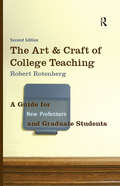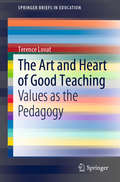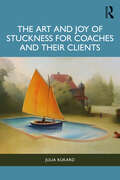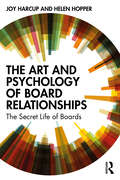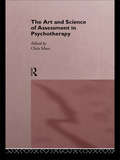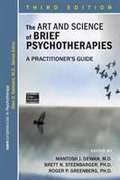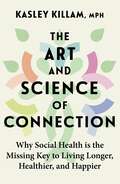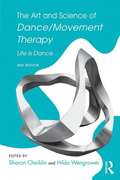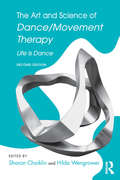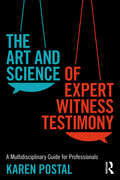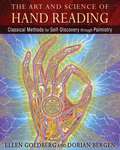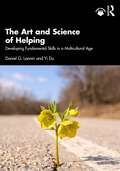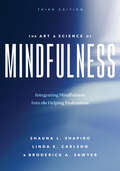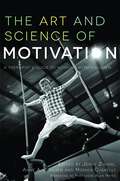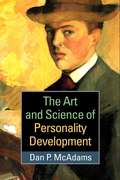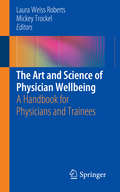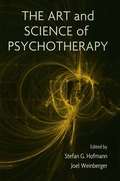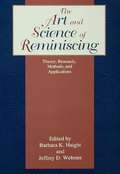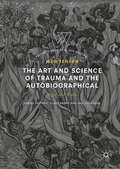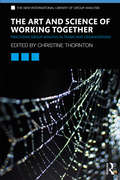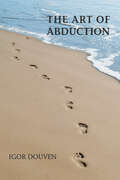- Table View
- List View
The Art and Craft of College Teaching: A Guide for New Professors and Graduate Students
by Robert RotenbergThe second edition of Rotenberg’s popular guide to college teaching includes additional material on teaching in a digital environment, universal design, and teaching diverse students. As in the first edition, the book provides a hands-on, quick-start guide to the complexities of the college classroom for instructors in their first five years of teaching independently. The chapters survey the existing literature on how to effectively teach young adults, offering specific solutions to the most commonly faced classroom dilemmas. The author, a former department chair and award-winning instructor, encourages the new teacher to support their students as individual learners who are engaged in a program of study beyond their individual class. A focus on the choices made during the design of the course helps the instructor coordinate their class with a department or college curriculum. An extensive discussion of the relationship between classroom design and class size, as well as tips of assessment and grading, enable the new instructor to better handle the challenges of contemporary college classrooms.
The Art and Heart of Good Teaching: Values as the Pedagogy (SpringerBriefs in Education)
by Terence LovatThis book summarizes and updates findings from the Australian Values Education Program with a focus on the latest international research in the field, both theoretical and practice-based. Further, it provides a theoretical and practical basis for understanding the disenchantment with low-level accountability approaches to learning (e.g. NAPLAN in Australia). In turn, the book demonstrates the effectiveness of Values Education as a holistic pedagogy with the potential to enhance students’ learning effects in terms of their personal, social, emotional and academic development. It offers well-tested alternative pedagogical approaches, based on research insights largely originating from actual classroom-based practice.
The Art and Joy of Stuckness for Coaches and their Clients
by Julia KukardThis book offers an existential understanding of the process of stuckness, exploring how we can soften stuckness and become more fluid in our work and world.We can’t avoid getting stuck, it’s a vital part of learning and healing, but we can develop the skills to get stuck less painfully and recover quicker. When we do this, stuckness can enable us to process our pasts and incubate our futures. Illustrated by relatable, global case studies, this book will help readers and coaches understand and work with stuckness in their own and their clients’ lives.Based on the author's doctoral research and extensive experience as a coach and coach trainer globally, this book is valuable to coaches, therapists, and human development practitioners.
The Art and Psychology of Board Relationships: The Secret Life of Boards
by Joy Harcup Helen HopperThe relationships within boards can make or break an organisation, but well-functioning relationships take skill and effort to maintain. This book looks at the psychology behind individual and group behaviour and offers tactics and power tools to help make a success of your board career. The book shares advice and practical tips from 40 experienced board members from the worlds of corporates, the public sector and charities on how to spot and manage complex dynamics. And each chapter ends with techniques for unlocking tricky board relationships that you can put into practice immediately. The authors examine case studies and explore topics such as psychodynamics, cognitive behavioural psychology and neuroscience for insights into how boards react under pressure. They then demonstrate how to practise the ART of managing board relationships by increasing Awareness, Relating constructively to others, and choosing Tactics to ease tensions and foster collaboration. The Art and Psychology of Board Relationships: The Secret Life of Boards reveals why board relationships lie at the heart of organisational success – and how you can use them to gain competitive edge. It is essential reading for current and aspiring board members, coaches, facilitators and anyone with an interest in boardroom dynamics.
The Art and Science of Assessment in Psychotherapy
by Chris MaceWhile professional trainings in psychotherapy and counselling vary considerably in the attention they pay to assessment, courses, conferences and workshops devoted to the subject are attracting an audience eager for more demonstration and discussion. In response, The Art and Science of Assessment in Psychotherapy offers an extended symposium on principles and practice. Guided by a belief that comparative study will spur critical reflection and innovation, its presentations encompass a wide range of therapeutic orientations, settings and interests. In the book twelve distinguished practitioners of widely used approaches within psychotherapy describe the methods they use in their assessments and how these have developed. They also discuss the uses and limitations of the therapies they offer. The approaches covered include psychoanalytic psychotherapy, in-patient psychotherapy, family therapy, group psychotherapy, psychodrama, cognitive-behaviour therapy, couple therapy and focal therapy. Additional chapters look at assessment in the light of psychotherapy research, question how far assessment can be separated from treatment, and ask whether the use of questionnaires and special tests aids or detracts from interviewing as a method of assessment. As psychotherapy matures as a profession, both chronologically and in response to public demand, interest in assessment methods is growing, yet to date the published material has been limited and dispersed amongst specialist books and journals. The Art and Science of Assessment in Psychotherapy offer the first comprehensive, practical review of a key professional issue which will be of interest to all practising psychotherapists and counsellors.
The Art and Science of Brief Psychotherapies: A Practitioner's Guide
by Brett N. Steenbarger Mantosh J. Dewan Roger P. GreenbergWith all of the expert-authored content that made previous editions indispensable references for students and practitioners alike, this third edition of The Art and Science of Brief Psychotherapies: A Practitioner's Guide has been updated to reflect this rapidly changing field. Most chapters include new material that documents recent developments within existing models, and new chapters tackle topics that include the following: * Multicultural practice* Mentalizing* Motivational interviewing* Dialectical behavior therapy* Telepsychiatry* Internet-based interventions All chapters summarize the ideas underlying each modality, the evidence for effectiveness, and the techniques and interventions central to each. In a national and global environment of limited economic resources and multiple demands on patients' time, short-term treatment modalities are increasingly important. Integrating theory, research, and step-by-step procedures, The Art and Science of Brief Psychotherapies is an ideal introduction to the range of short-term therapies for psychiatry residents, psychology interns, social work students, and experienced practitioners looking to broaden their practice.
The Art and Science of Connection: Why Social Health Is the Missing Key to Living Longer, Healthier, and Happier
by Kasley Killam2025 NAUTILUS BOOK AWARDS GOLD WINNER * 2024 LIVING NOW BOOK AWARDS GOLD MEDAL WINNER * HARVARD PUBLIC HEALTH MAGAZINE BEST BOOK OF 2024 * ASPEN IDEAS RECOMMENDED HEALTH BOOK OF 2024 A groundbreaking redefinition of what it means to be healthy that introduces the need for social health—the part of wellbeing that comes from feeling connected—to truly flourish.Exercise. Eat a balanced diet. Go to therapy. Most wellness advice is focused on achieving and maintaining good physical and mental health. But Harvard-trained social scientist and pioneering social health expert Kasley Killam reveals that this approach is missing a vital component: human connection.Relationships not only make us happier, but also are critical to our overall health and longevity. Research shows that people with a strong sense of belonging are 2.6 times more likely to report good or excellent health. Perhaps even more astonishingly, people who lack social support are up to 53% more likely to die from any cause. Yet social health has been overlooked and underappreciated—until now.Just as we exercise our physical muscles, we can strengthen our social muscles. Weaving together cutting-edge science, mindset shifts, and practical wisdom, Killam offers the first methodology for how to be socially healthy. An antidote to the loneliness epidemic and an inspiring manifesto for seeing wellbeing as not only physical and mental, but also social, The Art and Science of Connection is a handbook for thriving.In this essential book, you will:Learn a simple yet powerful framework to understand, evaluate, and bolster your social health.Discover the exact strategy or habit you need, as well as research-backed tips, to cultivate and sustain meaningful connection now and throughout your life.Glean actionable insights to develop a sense of community in your neighborhood, at work, and online from a spirited group of neighbors in Paris, the CEO of a major healthcare company, and an artificially intelligent chatbot.Get an insider look at the innovative ways that doctors, teachers, entrepreneurs, architects, government leaders, and everyday people are catalyzing a movement toward a more socially healthy society.The Art and Science of Connection will transform the way you think about each interaction with a friend, family member, coworker, or neighbor, and give you the tools you need to live a more connected and healthy life—whether you are an introvert or extrovert, if you feel stretched thin, and no matter your age or background. Along the way, Killam will reveal how a university student, a newlywed, a working professional, and a retired widow overcame challenges to thrive through connection—and how you can, too.
The Art and Science of Connection: Why Social Health is the Missing Key to Living Longer, Healthier, and Happier
by Kasley KillamA groundbreaking redefinition of what it means to be healthy that introduces the need for social health - the part of wellbeing that comes from feeling connected - to truly flourish.Exercise. Eat a balanced diet. Go to therapy. Most wellness advice is focused on achieving and maintaining good physical and mental health. But Harvard-trained social scientist and pioneering social health expert Kasley Killam reveals that this approach is missing a vital component: human connection.Relationships not only make us happier, but also are critical to our overall health and longevity. Research shows that people with a strong sense of belonging are 2.6 times more likely to report good or excellent health. Perhaps even more astonishingly, people who lack social support are up to 53% more likely to die from any cause. Yet social health has been overlooked and underappreciated - until now.Just as we exercise our physical muscles, we can strengthen our social muscles. Weaving together cutting-edge science, mindset shifts, and practical wisdom, Killam offers the first methodology for how to be socially healthy. An antidote to the loneliness epidemic and an inspiring manifesto for seeing wellbeing as not only physical and mental, but also social, The Art and Science of Connection is a handbook for thriving.In this essential book, you will:- Learn a simple yet powerful framework to understand, evaluate, and bolster your social health.- Discover the exact strategy or habit you need, as well as research-backed tips, to cultivate and sustain meaningful connection now and throughout your life.- Glean actionable insights to develop a sense of community in your neighbourhood, at work, and online from a spirited group of neighbours in Paris, the CEO of a major healthcare company, and an artificially intelligent chatbot.- Get an insider look at the innovative ways that doctors, teachers, entrepreneurs, architects, government leaders, and everyday people are catalysing a movement toward a more socially healthy society.The Art and Science of Connection will transform the way you think about each interaction with a friend, family member, coworker, or neighbour, and give you the tools you need to live a more connected and healthy life - whether you are an introvert or extrovert, if you feel stretched thin, and no matter your age or background. Along the way, Killam will reveal how a university student, a newlywed, a working professional, and a retired widow overcame challenges to thrive through connection-and how you can, too.
The Art and Science of Dance/Movement Therapy Life is Dance: Life is Dance (2nd Edition)
by Hilda Wengrower Sharon ChaiklinThis second edition of The Art and Science of Dance/Movement Therapy offers a broad understanding of dance/movement therapy as well as an in-depth exploration of how and where it can be used to produce change. The chapters that make up this innovative volume go beyond the basics to offer a unique collection of theoretical perspectives paired with case studies designed to emphasize techniques that can be applied in a variety of settings. In addition to boasting thoroughly expanded versions of all previously published content, this timely reference includes an all new chapter on DMT interventions in palliative care and added references throughout to reflect to the most current knowledge.
The Art and Science of Dance/Movement Therapy: Life Is Dance
by Hilda Wengrower Sharon ChaiklinThe Art and Science of Dance/Movement Therapy offers both a broad understanding and an in-depth view of how and where dance therapy can be used to produce change. The chapters go beyond the basics that characterize much of the literature on dance/movement therapy, and each of the topics covered offers a theoretical perspective followed by case studies that emphasize the techniques used in the varied settings. Several different theoretical points of view are presented in the chapters, illuminating the different paths through which dance can be approached in therapy.
The Art and Science of Expert Witness Testimony: A Multidisciplinary Guide for Professionals
by Karen PostalFeaturing in-depth interviews of attorneys, judges, and seasoned forensic experts from multiple disciplines including psychology, medicine, economics, history, and neuropsychology, The Art and Science of Expert Witness Testimony highlights and offers bridges for the areas where the needs and expectations of the courtroom collide with experts’ communication habits developed over years of academic and professional training. Rather than seeing testimony as a one-way download from expert to jurors, The Art and Science of Expert Witness Testimony focuses on the direct, dynamic, unique communication relationship that develops as each juror’s lived experience interacts with the words of experts on the stand. This book expands the academic tradition of "methods-centered credibility" to also include "person-centered credibility," where warmth, confidence, and relentless attention to detail build trust with jurors. Seasoned forensic experts share what they actually say on the stand: their best strategies and techniques for disrupting traditional academic communication and creating access to science and professional opinions with vivid, clear language and strong visuals. The difficult but necessary emotional work of the courtroom is addressed with specific techniques to regulate emotions in order to maintain person-centered credibility and keep the needs of jurors front and center through cross-examination. This innovative compilation of research is essential reading for professionals and practitioners, such as physicians, engineers, accountants, and scientists, that may find themselves experts in a courtroom. The Art and Science of Expert Witness Testimony provides a unique experience for readers, akin to being personally mentored by over eighty-five attorneys, judges, and seasoned experts as they share their observations, insights, and strategies—not to "win" as a defense, prosecution, or plaintiff expert, but to be productive in helping jurors and other triers of fact do their difficult intellectual job in deciding a case.
The Art and Science of Hand Reading: Classical Methods for Self-Discovery through Palmistry
by Ellen Goldberg Dorian BergenA comprehensive guide to the inner psychology revealed by the hand • Details how to interpret the entire hand--the shape of the palm and fingers, mounts, lines, fingerprints, flexibility, nails, and skin texture • Reveals the personality archetypes, strengths, and weaknesses connected with each of the seven mounts and how the rest of the hand modifies these traits • Explains how lines change and the decisive influence of the person’s own mind in healing defects found on the lines Palmistry is a science and a universal language. The hand tells a story about your talents, relationships, health, and how you feel about yourself. It reveals periods of ease or challenge in your life, and it speaks about your weaknesses and the traits you need to develop. As you change, so do your hands, reflecting the progress you have made. In this comprehensive guide to hand reading, based on Ellen Goldberg’s 40 years of teaching palmistry and the Western Mystery tradition, the authors make the powerful insights of the hand accessible in an inviting and user-friendly manner. The book presents the character traits and personality archetypes associated with each of the seven mounts of the palm and shows how to determine which are most influential in the nature of the individual. The mount archetypes reveal the lifestyle, love,sex, and marriage preferences; the best career choices; and the unique strengths and weaknesses for each person. The book also examines other factors that enhance the qualities revealed by the mount types, including the flexibility of the hand, texture of the skin, and the shapes of the fingers, fingertips, and nails. The meaning of each major and minor line is described in detail as well as the influence the person’s own mind has in healing defects and obstacles found on their lines. The authors also provide accurate timing guides for each line, making it possible to locate specific events and to see how your lines change over time. Presenting the hand as a guide to self-fulfillment, The Art and Science of Hand Reading incorporates correspondences to other mystical sciences such as astrology, Kabbalah, the Hermetic teachings, and archetypal psychology. It also includes practical examples and more than 600 illustrations to show how to integrate the meanings of each part of the hand to form a complete picture of your inner psychology and your ever-changing destiny.
The Art and Science of Helping: Developing Fundamental Skills in a Multicultural Age
by Yi Du Daniel G. LanninThe Art and Science of Helping: Developing Fundamental Skills in a Multicultural Age introduces the fundamentals of practicing helping-skills to undergraduates, graduates, and those preparing for entry-level helping professions.The text emphasizes best practices of the art of helping while rooting these practices in empirical, scientific findings. Readers will learn skills and techniques that prepare them for counseling and other helping professions while also developing multicultural competence and self-awareness. Chapters teach helpers who are training to navigate the different phases of helping, including connecting with clients, helping clients discover new understanding, and empowering clients to take action.The Art and Science of Helping aligns with a typical semester and includes ready-to-use classroom activities to develop helping skills and microskills. Each chapter includes multicultural considerations as well as reflections and exercises designed to enhance self-awareness—both critical competencies for burgeoning helping professionals.
The Art and Science of Making Up Your Mind
by Rex V. BrownThe Art and Science of Making Up Your Mind presents basic decision-making principles and tools to help the reader respond efficiently and wisely to everyday dilemmas. Although most decisions are made informally (whether intuitively without deliberate thought, or based on careful reflection), over the centuries people have tried to develop systematic, scientific and structured ways in which to make decisions. Using qualitative counterparts to quantitative models, Rex Brown takes the reader through the basics, like ‘what is a decision’ and then considers a wide variety of real-life decisions, explaining how the best judgments can be made using logical principles. Combining multiple evaluations of the same judgment ("hybrid judgment") and exploring innovative analytical concepts (such as "ideal judgment"), this book explores and analyzes the skills needed to master the basics of non-mathematical decision making, and what should be done, using real world illustrations of decision methods. The book is an ideal companion for students of Thinking, Reasoning and Decision-Making, and also for anyone wanting to understand how to make better judgments in their everyday lives.
The Art and Science of Mindfulness: Integrating Mindfulness Into the Helping Professions
by Linda E. Carlson Shauna L Shapiro Broderick A. SawyerNow in its third edition, The Art and Science of Mindfulness offers a deeper understanding of the concept of mindfulness and explores its potential as a core clinical skill and a way to increase the well-being of both clients and clinicians. Mindfulness helps us to see clearly so that we can make choices grounded in reality and respond to life with wisdom. However, seeing clearly is difficult because the lens through which we view the world is blurred by our parents, teachers, relationships, and society, and they influence our perceptions on conscious and subconscious levels. Practicing mindfulness helps us remove the filters, biases, and preconceived ideas that shape our perceptions and cloud our consciousness. At the deepest level, mindfulness is about freedom: freedom from reflexive patterns, freedom from reactivity, and, ultimately, freedom from suffering. This book navigates how mindful awareness is fundamental to the therapy process, and shows how mindful practice can help therapists and clients cultivate and connect with this deeper awareness. It also aims to present mindfulness as: an important dimension of clinical training with unique contributions toward fostering attention, empathy, presence, and awareness of our own biases and assumptions an empirically supported clinical intervention effective across a wide range of populations a means of fostering self-reflection and self-care for clinicians a way to expand the profession's focus on pathology to include positive growth and development New to this edition is a comprehensive overview of the evidence supporting the neurochemical basis of intention, attention, and attitude; a discussion of implicit bias and how it interferes with connecting mindfully with clients; a discussion of new mindfulness-based interventions and ways to apply mindfulness in therapy, and more.
The Art and Science of Motivation
by Jenny Ziviani Anne A. Poulsen Monica CuskellyPlacing motivation at the heart of all encounters and therapeutic activities, this book presents a groundbreaking, evidence-based model for working with children, including those with physical disabilities, learning disabilities and emotional and behavioural difficulties. Drawing on Self-Determination Theory (SDT), the authors describe this innovative paradigm - the model of Synthesis of Child, Occupational Performance and Environment - in Time (SCOPE-IT) - and explain how it can be used to sustain the child's motivation and active involvement in the therapeutic process. They suggest ways of using language and of structuring and working with the environment to maximise engagement and autonomy and achieve the best possible treatment outcomes. The challenges professionals may face when working with children are also clearly addressed, and engaging case studies and photographs place the key theoretical concepts in a richly human and personal context. Combining accessible theory with a wealth of tools and strategies for practice, this book is essential reading for all those working therapeutically with children, including occupational therapists, speech and language therapists, psychologists and psychotherapists.
The Art and Science of Personality Development
by Dan P. McadamsDrawing on state-of-the-art personality and developmental research, this book presents a new and broadly integrative theory of how people come to be who they are over the life course. Preeminent researcher Dan P. McAdams traces the development of three distinct layers of personality--the social actor who expresses emotional and behavioral traits, the motivated agent who pursues goals and values, and the autobiographical author who constructs a personal story for life. Highly readable and accessible to scholars and students at all levels, the book uses rich portraits of the lives of famous people to illustrate theoretical concepts and empirical findings.
The Art and Science of Physician Wellbeing: A Handbook for Physicians and Trainees
by Laura Weiss Roberts Mickey TrockelThis thoughtful and timely book offers physicians and trainees a wide range of insights and strategies to help ensure not only a healthy lifestyle and sense of wellbeing but the best possible career in medicine as well. With evidence and evidence-informed practices provided by experts, this title affirms the culture of medicine while embracing the fundamental, enduring sense of physicians’ calling and affirming the importance of physicians as individuals whose health and wellbeing has intrinsic value and value to others. Organized in three parts, the first part focuses on the nature of the health professions and on advancing a culture of wellbeing in medicine. The second part focuses on threats to physician wellbeing, including mistreatment during training and burnout, to name just a few. The third part outlines approaches to strengthening physician resilience, such as the sustenance drawn from healthy relationships, mindfulness approaches, and optimal approaches to exercise, nutrition and sleep. The Handbook of Personal Health and Wellbeing for Physicians and Trainees is an invaluable, handy resource for physicians and trainees. Physician assistants, nurse practitioners, clinical psychologists, and social workers will also find the work of great interest.
The Art and Science of Psychotherapy
by Stefan G. Hofmann Joel WeinbergerPsychotherapy, like most other areas of health care, is a synthesis of scientific technique and artistic expression. The practice, like any other, is grounded in a series of standardized principles, theories, and techniques. Individual practitioners define themselves within the field by using these basic tools to achieve their therapeutic goals in novel ways, applying these rudimentary skills and guiding principles to each situation. However, a toolbox full of treatment approaches, no matter how comprehensive, is not enough to effectively reach your patients. Effective work can only be accomplished through a synthesis of the fundamental scientific methods and the creative application of these techniques, approaches, and strategies. The Art and Science of Psychotherapy offers invaluable insight into the creative side of psychotherapy. The book addresses the fundamental split between researchers and scholars who use scientific methods to develop disorder-specific treatment techniques and those more clinically inclined therapists who emphasize the individual, interpersonal aspects of the therapeutic process. With contributions from leading therapists, the editors have compiled a practical handbook for clinical psychologists, social workers, psychiatrists, and mental health professionals.
The Art and Science of Relationship: The Practice of Integrative Psychotherapy
by Janet Moursund Richard G ErskineThis is an easy-to-read explication of relationally focused integrative psychotherapy/counselling that will be enjoyed by novice and experienced mental health professionals worldwide. Richard Erskine and Janet Moursund illuminate the central role of the therapeutic relationship, and of relationships in general, both in the healing process and in maintaining a psychologically healthy life. They posit that the therapeutic relationship is key to helping clients become integrated or whole, and present both theory and practice to demonstrate this view. The book is divided into three parts: Theoretical Foundations, Therapeutic Practice, and a full verbatim transcript of a therapy session. The book's unique feature is the linkage of the transcript section with the earlier, theoretical and practice-oriented sections to clearly show how theory can be applied in the consulting room. For virtually every exchange between therapist and patient, the reader is directed back to a discussion of the specific aspect of theory and method that underly the actual words being spoken. The result is theory brought to life, theory brought out of the classroom or the professional workshop and into the real world of ongoing psychotherapy. This book is highly recommended for students and practitioners of psychotherapy, counselling, and clinical psychology, and will be of interest to all those who work in a mental health setting.
The Art and Science of Reminiscing: Theory, Research, Methods, and Applications
by Jeffrey D. Webster Barbara K. HaightFirst published in 1995. Routledge is an imprint of Taylor & Francis, an informa company.
The Art and Science of Trauma and the Autobiographical: Negotiated Truths (Palgrave Studies in Life Writing)
by Meg JensenThis book examines posttraumatic autobiographical projects, elucidating the complex relationship between the ‘science of trauma’ (and how that idea is understood across various scientific disciplines), and the rhetorical strategies of fragmentation, dissociation, reticence and repetitive troping widely used the representation of traumatic experience. From autobiographical fictions to prison poems, from witness testimony to autography, and from testimonio to war memorials, otherwise dissimilar projects speak of past suffering through a limited and even predictable discourse in search of healing. Drawing on approaches from literary, human rights and cultural studies that highlight relations between trauma, language, meaning and self-hood, and the latest research on the science of trauma from the fields of clinical, behavioral and evolutionary psychology and neuroscience, I read such autobiographical projects not as ‘symptoms’ but as complex interrogative negotiations of trauma and its aftermath: commemorative and performative narratives navigating aesthetic, biological, cultural, linguistic and emotional pressure and inspiration.
The Art and Science of Working Together: Practising Group Analysis in Teams and Organisations (The New International Library of Group Analysis)
by Christine ThorntonThe Art and Science of Working Together: Practising Group Analysis in Teams and Organizations is a primary resource for anyone wishing to learn more about the complex unconscious dynamics of organizations, providing a practical guide for organizational work, a guide to how to improve things, and a strong theoretical foundation in the group analytic concept of the ‘tripartite matrix’. Group analysis is a highly developed science of group relationships, which allows complexity and systems perspectives to be held in mind alongside organizational psychology, strategic development and business wisdom. Organized into eight sections, the book describes the essence of organizational group analysis, including the art of conversation, leadership, ethical issues in team working, and working with whole organizations. It addresses issues such as ‘us-and-them’ dynamics, the nature of systems boundaries, and the relationship between an organization and its context. Leaders and leading consultants give case studies, describing their thinking as they work, to illustrate the theory in action. This essential new resource will allow clinically trained practitioners to extend their scope into organizational work, and all coaches and leaders to benefit from knowledge of the group analytic discipline. It is essential reading for consultants and coaches working with teams and organizations, and for leaders within organizations.
The Art of Abduction
by Igor DouvenA novel defense of abduction, one of the main forms of nondeductive reasoning.With this book, Igor Douven offers the first comprehensive defense of abduction, a form of nondeductive reasoning. Abductive reasoning, which is guided by explanatory considerations, has been under normative pressure since the advent of Bayesian approaches to rationality. Douven argues that, although it deviates from Bayesian tenets, abduction is nonetheless rational. Drawing on scientific results, in particular those from reasoning research, and using computer simulations, Douven addresses the main critiques of abduction. He shows that versions of abduction can perform better than the currently popular Bayesian approaches—and can even do the sort of heavy lifting that philosophers have hoped it would do. Douven examines abduction in detail, comparing it to other modes of inference, explaining its historical roots, discussing various definitions of abduction given in the philosophical literature, and addressing the problem of underdetermination. He looks at reasoning research that investigates how judgments of explanation quality affect people&’s beliefs and especially their changes of belief. He considers the two main objections to abduction, the dynamic Dutch book argument, and the inaccuracy-minimization argument, and then gives abduction a positive grounding, using agent-based models to show the superiority of abduction in some contexts. Finally, he puts abduction to work in a well-known underdetermination argument, the argument for skepticism regarding the external world.
The Art of Art Therapy: What Every Art Therapist Needs to Know
by Judith A. RubinThe Art of Art Therapy is written primarily to help art therapists define and then refine a way of thinking about their work. This new edition invites the reader to first consider closely the main elements of the discipline embodied in its name: The Art Part and The Therapy Part. The interface helps readers put the two together in an integrated, artistic way, followed by chapters on Applications and Related Service. Included with this edition is a DVD containing two hours of chapter-related video content.
